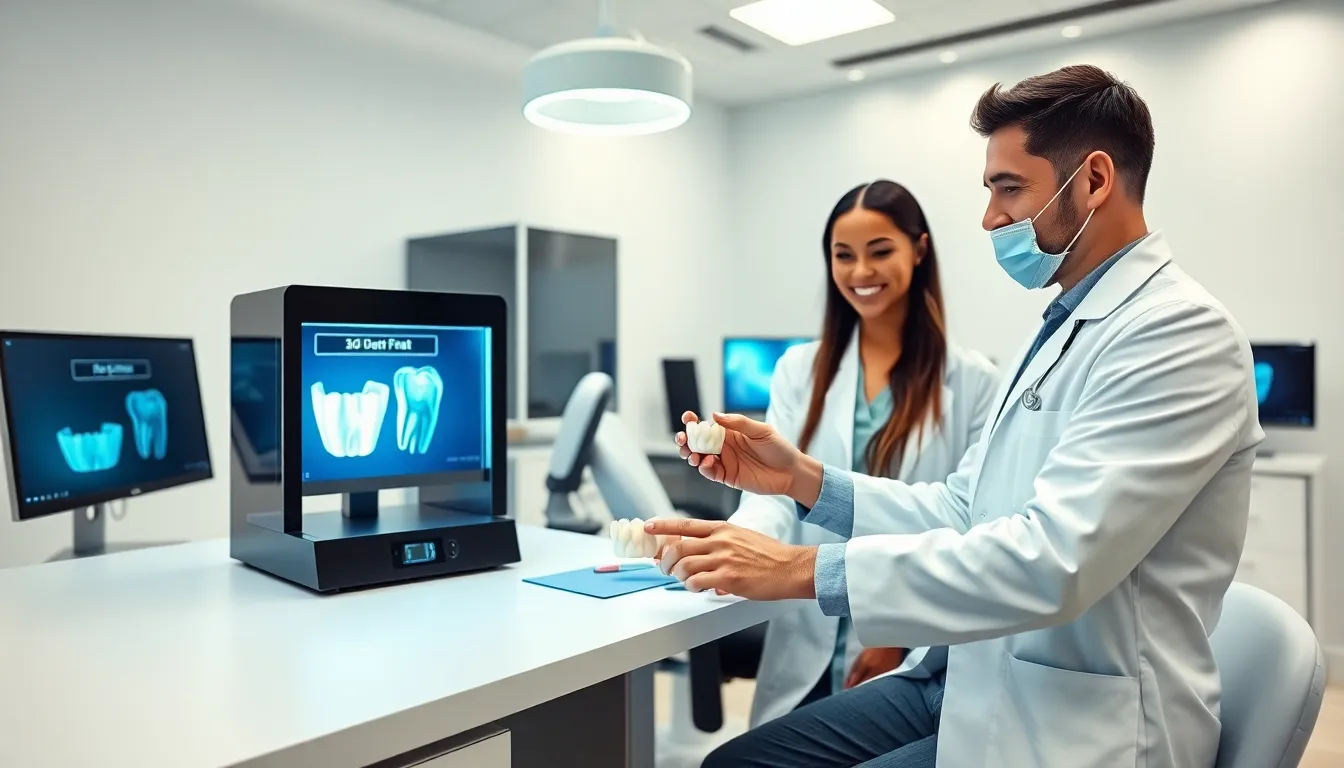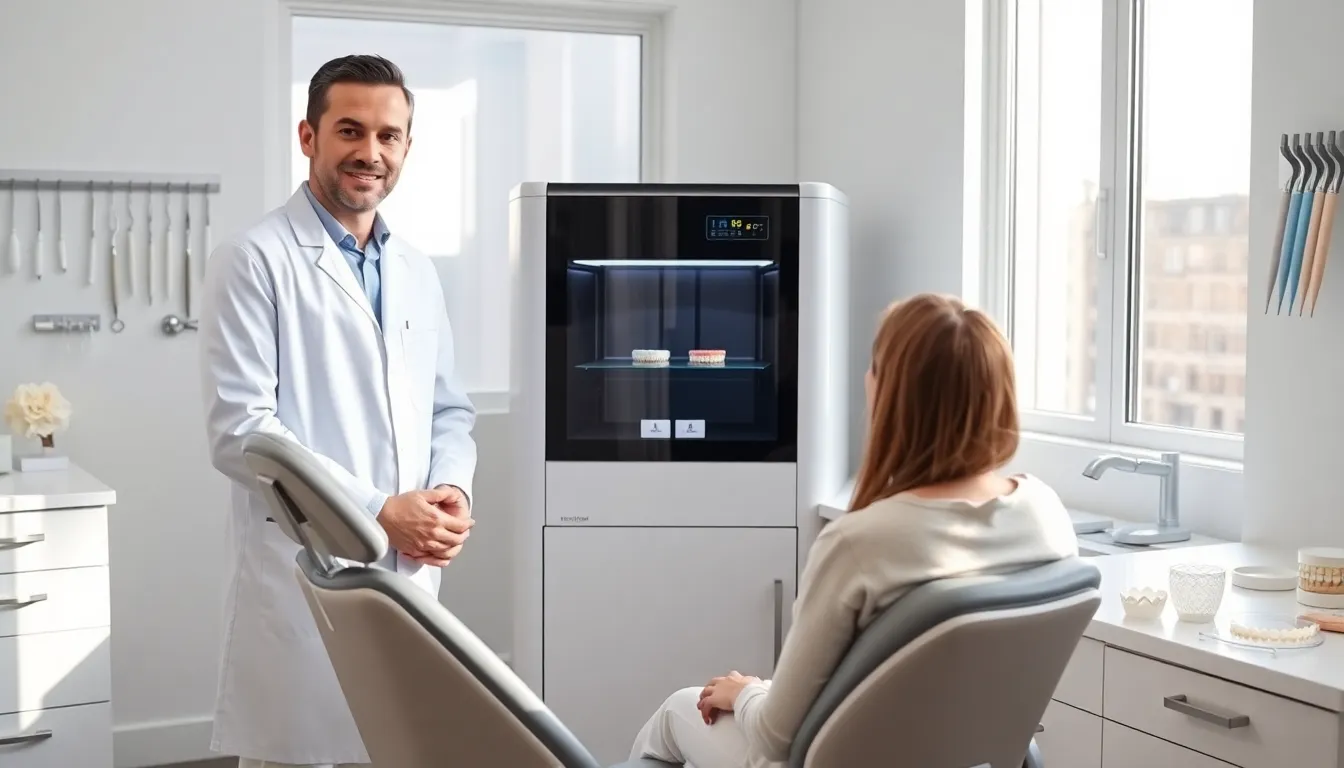Table of Contents
ToggleImagine a world where your dentist creates your crown in minutes instead of weeks. Enter dental 3D printing, the game changer in oral healthcare. Gone are the days of gooey impressions and waiting for lab work. This technology not only enhances precision but also gives you a glimpse into the future of dentistry. So, why should you care? Innovations in this field could mean pain-free procedures, quicker visits, and better oral health for everyone. Get ready to jump into the exciting universe of dental 3D printing.
Overview of Dental 3D Printing

Dental 3D printing refers to the process of creating three-dimensional objects using digital files specifically in the realm of dentistry. This innovative technology allows dental professionals to produce a variety of items, from crowns and bridges to dentures and surgical guides, all tailored to the individual patient. Utilizing computer-aided design (CAD) and various printing methods, dental 3D printing offers benefits that go beyond traditional crafting methods. Most importantly, it enhances precision and minimizes waste, paving the way for a more efficient dental practice.
The shift from conventional methods to 3D printing signifies a dramatic change in how oral healthcare is delivered. Not only does it streamline the workflow in dental offices, but it also personalizes treatments. By leveraging this cutting-edge technology, dentists can create high-quality, patient-specific products on-site, reducing the typical turnaround time. In essence, dental 3D printing is transforming patient experience, making dental procedures faster and more efficient.
Key Technologies in Dental 3D Printing
Several key technologies drive the realm of dental 3D printing. Two of the most prominent methods are Stereolithography (SLA) and Fused Deposition Modeling (FDM).
Stereolithography (SLA)
SLA utilizes a laser to cure liquid resin into hardened plastic. This method is particularly well-suited for dental applications that require high precision, such as creating dental aligners and crowns. The precision level of SLA printers can produce detailed features that are essential in dentistry.
Fused Deposition Modeling (FDM)
FDM works by extruding thermoplastic filament layer by layer. While it’s generally considered less precise than SLA, it’s gaining traction due to its cost-effectiveness and ability to produce functional parts quickly. FDM is often used for creating dental models and prototypes, making it easier for practitioners to visualize and plan treatments.
Plus to these, newer technologies like Digital Light Processing (DLP) and Selective Laser Sintering (SLS) are also making waves in the industry. DLP offers faster printing times because it utilizes a digital light projector to cure resin, while SLS employs lasers to fuse powdered materials, allowing for more complex geometries. Both methods are expanding the possibilities of what dental professionals can create.
Applications of 3D Printing in Dentistry
The applications of 3D printing in dentistry are diverse and continually expanding, showcasing its versatility and potential benefits. Some of the most common applications include:
Custom Dental Prosthetics
Dental 3D printing is widely used to produce crowns, implants, dentures, and bridges. Each of these prosthetics can be tailored specifically for the patient, leading to better fit and aesthetics.
Surgical Guides
Dentists are also employing 3D printing to create surgical guides that help in precise implant placement. These guides are instrumental in improving the accuracy of the procedures, eventually leading to better outcomes for patients.
Orthodontics
In orthodontics, 3D printing allows for the production of aligners that are customized for individual use. With digital scans and CAD files, professionals can generate clear aligners that align teeth more effectively than traditional braces.
Education and Training
Another notable application involves using 3D printed models for education and training. Dental students can practice on lifelike models that replicate various dental conditions, enhancing their learning experience.
Benefits of Dental 3D Printing
Dental 3D printing comes adorned with numerous benefits that positively impact both practitioners and patients alike. Here are some noteworthy advantages:
Enhanced Precision
One significant benefit of dental 3D printing is the enhanced precision it offers. With computer models guiding each print, products are often made to fit perfectly, reducing the need for adjustments after the fact.
Faster Turnaround
The speed at which dental 3D printers operate is astounding. Processes that traditionally took weeks can now be completed in mere hours or days. This quick turnaround means happier patients and increased efficiency for dental practices.
Cost-Effectiveness
Although the initial investment in 3D printers can be daunting, the long-term savings are noteworthy. By reducing material waste and eliminating the need to send jobs to external labs, dental practices can significantly cut costs over time.
Customization
Each patient is unique, and dental 3D printing accommodates this individuality beautifully. From personalized fit to aesthetic preferences, treatments can now be tailored to meet specific needs, enhancing patient satisfaction.
Challenges and Limitations of Dental 3D Printing
Even though the monumental benefits of dental 3D printing, it’s not without its challenges and limitations. Understanding these hurdles is crucial for those considering introducing this technology into their practice.
Initial Costs
The upfront investment for high-quality dental 3D printers can be significant, which may deter some practices from adopting this technology. Also, the ongoing costs for materials and maintenance can add up.
Regulatory Issues
Regulatory considerations can also complicate matters. Ensuring compliance with dental industry standards requires ongoing education and attention to detail, posing a barrier for some practitioners.
Material Limitations
Not all materials used in 3D printing meet the required strength and aesthetic qualities needed in dentistry. Some materials may not provide the necessary durability, which is a concern for long-term dental solutions.
Future Trends in Dental 3D Printing
The future of dental 3D printing is brimming with potential. As the industry continues to evolve, several trends are emerging.
Integration of Artificial Intelligence
AI is set to play an increasing role in enhancing the capabilities of 3D printing. From predictive modeling to optimizing designs for better outcomes, the combination of AI with 3D technology promises more efficient processes.
Advanced Materials
Emerging materials that promise better durability and aesthetics are already in the development stage. As these materials become more widely available, the quality of 3D-printed dental products is expected to improve considerably.
Increased Accessibility
As costs decrease and awareness increases, more dental practices, including smaller and rural offices, will likely adopt 3D printing technologies, democratizing access to advanced dental care.







